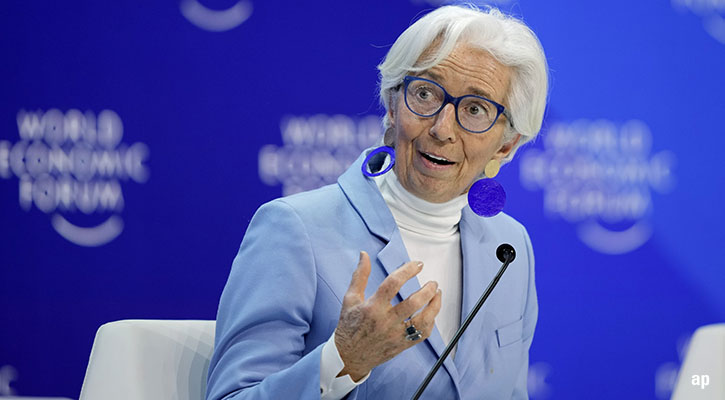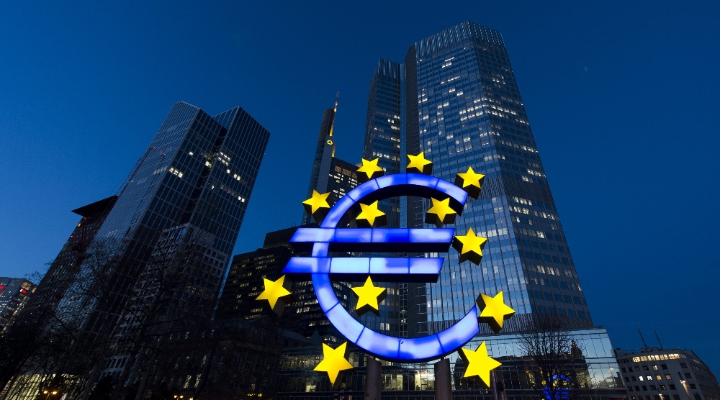
The European Central Bank’s first meeting of the year will be closely watched for any signs of a doveish turn for the Governing Council. But central bankers have been trying to dampen such hopes in recent weeks.
Financial markets are currently pricing in that the ECB will begin cutting key interest rates in the spring, with four more cuts to follow later in the year; some 150 basis points of cuts are expected in 2024.
When Will the ECB Start Cutting Rates?
A lot has happened since the Governing Council’s decided in December to keep rates unchanged at 4.5%, with President Christine Lagarde telling reporters the council "did not discuss rate cuts at all".
For one, underlying inflation is falling. While headline inflation in the eurozone was up in December, core inflation, which shows price changes without the cost of energy and food, fell 20 basis points to 3.4%. Price momentum is likely to slow further from February, the Blackrock Investment Institute expects. Inflation may even fall well below the 2% target temporarily in the coming months as the effects of the energy shock subside.
The ECB’s sole mandate is to rein in inflation to its target rate of 2%, but the crux is to achieve this without driving the Eurozone into a full-blown recession.
And recent macroeconomic data stoked fears that this is exactly where the single currency area might be headed. Industrial production was down by 0.3% in November month-on-month, according to Eurostat data published last week. Meanwhile the bloc’s largest economy Germany is heading for a second year of recession as “multiple crises” continue to dampen growth, the head of the country’s statistics office said last week. The German economy shrank by 0.3% in 2023 compared to 2022.
“Inflation is falling and the economy is in danger of a recession. That gives policy makers the opportunity to cut rates,” says Michael Field, European market strategist at Morningstar.
ECB Pushes Back Against Rate Cut Expecations
Christine Lagarde told Bloomberg at the World Economic Forum in Davos last week that the bank is likely to cut rates in the summer. She joined many of her fellow council members in trying to dampen expectations of an imminent easing.
Some council members expressed their dissatisfaction with the prevailing market expectation that the central bank would begin to cut key interest rates in the spring, said Dr Ulrich Kater, lead economist at Deka Bank. But before the first interest rate cut, the council will look for inflation to fall to 2% on a sustained basis. The bottom line is that the council considers it very unlikely that key interest rates will be lowered before its meeting in June, he said.
Katharine Neiss, chief European economist at PGIM Fixed Income, does not expect rate cuts in the next few months.
“Our reasoning is derived from ECB comments, which suggest that the Governing Council would like to see easing across a range of factors that influence underlying domestic inflationary pressure.
"This includes not only core and services inflation, but wages and firm markups as well. That would put Q2 as the earliest period in the frame for cuts. Put simply, it’s a case of once bitten, twice shy and policymakers will want to be sure that the inflation genie has been put firmly back in the bottle.”
In addition to the expectation of early rate cuts, the ECB will also try to tame expectations of the number of rate cuts (five or more this year), says Felix Feather, economist at Abrdn.
For mortgage holders, that means lower rates might still be in the far distance.
ECB, Fed, BoE: Don’t Expect Co-ordinated Cuts
That being said, the ECB has much more leeway to cut rates than its counterpart on the other side of the Atlantic. Last year, markets expected that central banks would start cutting rates simultaneously, and that is why even here in Europe there was such a focus on the Fed, says Morningstar’s Field. But the US economy is in danger of overheating and inflation is up again, so the Fed has a more difficult task, Field ads. Europeans should not be looking at the US to lead the way in monetary easing.
Currency markets have plenty to sink its teeth into this week, with the latest ECB lending sruvey on Tuesday and flash PMIs for January on Wednesday. These two data sets had weighed quite heavily on the euro last year and will be closely watched ahead of Thursday. The bank sees the EUR/USD largely unchanged around the 1.09 levels as the ECB tries to re-position for a data-dependent approach for future policy.



























